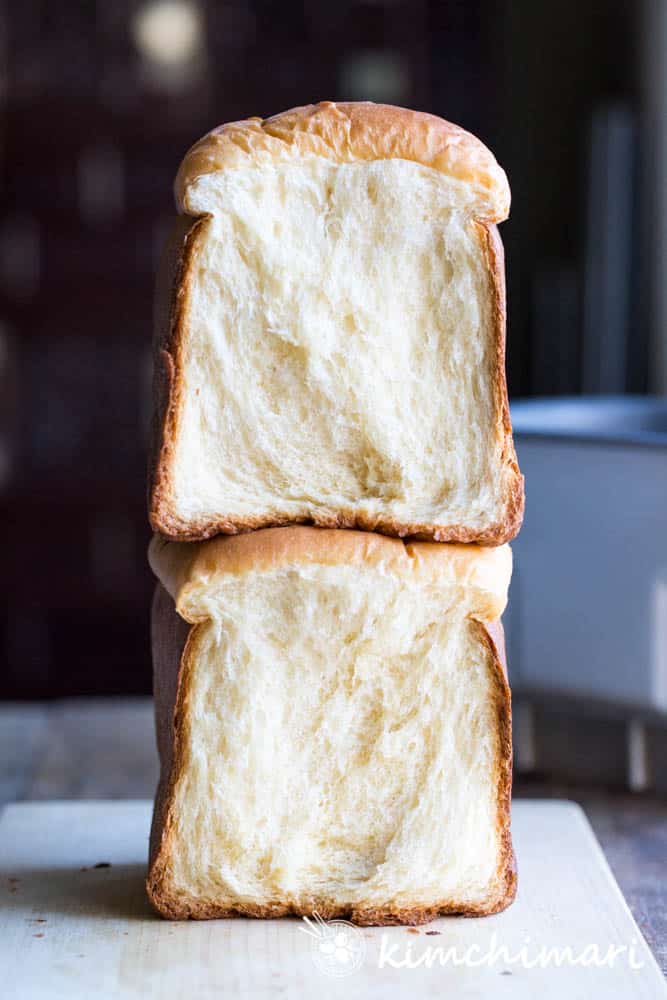Milk bread is a beloved favorite in Korea, Japan, and across many Asian countries. This buttery, soft, and light bread is irresistibly delicious and utterly addictive! Now, you can make this pillowy delight at home just like my original recipe, but with the convenience of a bread machine!
HOW IS MILK BREAD DIFFERENT FROM OTHER TYPES OF BREAD?
- Milk bread is incredibly moist, buttery, subtly sweet, and incredibly light. It incorporates a starter called Tangzhong, which helps the bread retain more moisture than typical bread recipes, resulting in a soft, moist loaf. If you prefer to skip the extra step of making the starter, you can use dry milk powder as an alternative.
- During the rising process, the dough is rolled, which creates a feathery, stringy texture—nothing like the crumbly texture of most sandwich breads. This makes milk bread perfect for toasting or making sandwiches like PB&J or egg salad.
INGREDIENTS
Wet Ingredients + Salt
3/4 cup 2% low-fat milk (use preheat function or warm the milk)
1/4 cup room temperature water
60 g unsalted butter (1/4 cup), melted
1 egg
1 tsp sea salt
Dry Ingredients
365 g unbleached bread flour (2 3/4 cups)
50 g sugar (3.5 Tbsp)
2 Tbsp milk powder
7 g instant yeast (1 packet = 2 tsp)
For Coating the Bowl and Pan
1 Tbsp unsalted butter

INSTRUCTIONS
- Melt Butter: Microwave the butter until fully melted (about 20-25 seconds on 50% power).
- Warm Milk & Water: Heat the milk to a warm bath-like temperature, and use room temperature water and eggs—especially if your bread machine doesn’t have a preheat function.
- Add Wet Ingredients: Pour the wet ingredients (milk, water, melted butter, and egg) along with the salt into the bread pan. I like to add the salt at this stage to ensure it doesn’t interfere with the yeast.
- Mix Dry Ingredients: In a bowl, mix the flour and sugar, then add them to the bread pan on top of the wet ingredients.
- Add Yeast & Milk Powder: Create a well in the center of the dry ingredients and add the yeast. Sprinkle the milk powder in a corner of the pan.
- Start the Dough Cycle: Place the bread pan in the machine and select the full Basic Dough cycle. This cycle takes about 1 hour 50 minutes, including two rising periods. If your machine lacks a dough cycle, you can use a stand mixer—refer to my regular milk bread recipe for details. The dough should look smooth and slightly sticky after the cycle finishes.
- Shape the Dough: Once the dough is done, punch it down. Transfer it to a flat surface and divide it into two equal pieces. Knead each piece lightly, then shape each into a tight ball.
- Second Rise: If your machine has a custom rise function, place the dough balls back in the pan and let them rise for 30 minutes. Otherwise, place the dough balls in separate bowls, cover with plastic wrap or a towel, and let them rise in a warm place (around 100℉) for 20 minutes.
- Roll & Shape the Dough: After the dough has risen, transfer one ball at a time to a lightly floured surface. Roll out the dough into a thick rectangle about 12 inches long and 4-5 inches wide. Fold the top and bottom edges inward, then roll it up tightly into a log.
- Prepare for Final Rise: Lightly butter the sides of the bread pan and place both dough logs in the pan. Put the pan back in the machine and set it to rise for 1 hour, or until the dough reaches about 70% of the pan’s height. If your machine lacks a custom rise function, let the dough rise at room temperature or in a 100℉ oven for 40 minutes.
- Bake: Once the dough has risen, bake the bread for 50 minutes. Adjust the crust setting to your preference (I usually set it to medium). For a glossy finish, brush the top of the dough with milk or egg whites before baking. Keep in mind that bread baked in a machine may not have the golden brown top like oven-baked bread, but the taste and texture are just as delicious as the original milk bread recipe.
EQUIPMENT
- Bread machine
- Mixing bowls
- Rolling pin
TIPS & NOTES
- Ensure all wet ingredients are at the right temperature to activate the yeast effectively.
- If you don’t have a bread machine, you can follow the same steps using a stand mixer for the kneading process.
- For a shinier top, try brushing the dough with milk or egg whites before baking.
- Bread baked in a machine may not get as golden as oven-baked bread, but the texture and flavor will still be wonderful!







